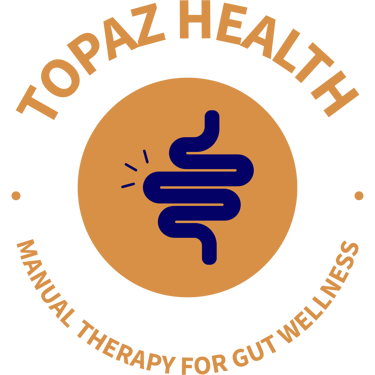
What is Visceral Osteopathy?
What is Visceral Osteopathy? Visceral osteopathy is a non-invasive treatment of the viscera (internal organs) and their connective tissues. Learn how this gentle form of osteopathy may help with gut health and more.
7/30/20246 min read
Introduction to Visceral Osteopathy
Viscera simply means internal organs and visceral osteopathy is a particular modality within the broader field of osteopathic medicine that focuses on the manipulation and mobilisation of the viscera. This therapeutic approach is rooted in the holistic principles of osteopathy, which emphasise the interconnectivity of the body's systems and the belief that optimal health can be achieved through improving alignment and function of all physiological components.
In visceral osteopathy osteopaths utilise a range of manual techniques to assess and treat dysfunctions within the viscera. The goal is to enhance the body's natural healing and self-regulating processes by improving the mobility, circulation and overall function of the organs. Osteopaths are trained to identify restrictions, adhesions and other abnormalities that may contribute to a range of health issues.
Osteopathy is underpinned by several core tenets, including the belief that the body has an inherent ability to heal itself and that structure and function are closely interrelated. By addressing visceral dysfunctions, osteopaths aim to restore balance and promote systemic health. This approach may be particularly beneficial in managing issues that may not respond well to conventional treatment. It is a non-invasive treatment offering a complementary approach for patients seeking holistic care.
How Visceral Osteopathy May Help
Visceral osteopathy focuses on the treatment of the internal organs and their associated tissues, whose mobility may be restricted. Restrictions may arise from inflammation and illness, trauma, scar tissue, postural issues, and stress, whether emotional, mental or physical, just to name a few.
One of the primary areas where visceral osteopathy is used is in the management of digestive issues. Problems such as sluggish digestion, constipation, bloating and reflux may all respond well to visceral manipulation. By improving the mobility and function of the digestive organs and their tissues, as well as any musculoskeletal issues that may be contributing to the problem, practitioners may help to improve digestive symptoms, abdominal pain and discomfort.
Respiratory issues are another area where visceral osteopathy may be beneficial. Techniques aimed at enhancing the mobility of the diaphragm, ribcage and lungs may help improve breathing patterns and chronic issues. By fostering better respiratory function, patients may experience a reduction in symptoms and overall improvement in their quality of life.
Gynaecological concerns such as painful periods may also be addressed through visceral osteopathy. By treating tissue restriction and improving mobility and blood flow to the area, overall pelvic health and optimal function of pelvic organs may be ameliorated.
In summary, visceral osteopathy offers a versatile and non-invasive treatment option for a range of health conditions. By addressing the root causes of dysfunction in the internal organs, it may help alleviate symptoms and improve overall well-being, making it a valuable tool in holistic healthcare.
How Visceral Osteopathy Works
Visceral osteopathy employs a series of gentle manipulations and mobilisations targeting the internal
organs and their surrounding tissues. The surrounding tissues are connective tissue structures that hold
the organs in place. These tissues also contain nerves, blood and lymph vessels which are vital for the
organ’s health.
Visceral osteopathy is used within the context of general osteopathic treatment whereby a whole-body
approach is utilised. It can be used to help manage various issues through targeted manual techniques. This holistic approach works by looking to address the underlying cause of discomfort.
Practitioners use their hands to apply precise, yet gentle pressure and movements to the abdomen, thorax and pelvis, aiming to alleviate restrictions and improve overall harmony within the body. By addressing any mechanical restrictions or imbalances, osteopaths aim to enhance the circulation of blood and lymphatic fluids, which is crucial for maintaining healthy organ function. Additionally, it can help improve neurological feedback and help to improve vagus nerve function, known as vagal tone. The vagus nerve is a component of the parasympathetic branch of the autonomic nervous system, often referred to as the rest and digest state. Having good vagal tone is vital for a balanced health and function of the viscera.
Improved circulation also ensures that organs receive the necessary nutrients and oxygen, while also facilitating the removal of metabolic waste products. Furthermore, these techniques can help release tension and adhesions in the connective tissues that surround the organs, which can otherwise lead to discomfort or dysfunction.
Other Benefits of Visceral Osteopathy
Another benefit of visceral osteopathy is helping with visceral pain sometimes referred to as visceral hypersensitivity. Visceral hypersensitivity is where the experience of pain or discomfort within the internal organs by an individual is considered lower than the normal threshold. This is common in functional gastrointestinal disorders like IBS for example. People with visceral hypersensitivity will often feel discomfort with normal functioning of their organs, for example response to pressure from gas within the intestines.
Enhanced mobility is another potential advantage. The interconnected nature of the body's systems means that restrictions in visceral tissues can impact musculoskeletal function. By releasing these restrictions, visceral osteopathy may help to improve overall mobility and flexibility. This is particularly beneficial for patients with conditions like lower back pain or hip discomfort, where the root cause may be tied to visceral dysfunction.
Overall well-being is another potential benefit. Visceral osteopathy aims to restore balance within the body, promoting a sense of harmony and relaxation. Many individuals who have visceral osteopathic treatment often report experiencing a more relaxed state.
Scientific Research on Visceral Osteopathy
Currently, there is limited research in the field of visceral osteopathy and the studies that do exist are often of smaller sample size. However, of the studies that have been conducted some have suggested that visceral osteopathy may have potential benefits for reflux, constipation, IBS, abdominal pain and abdominal distention. The results of these studies indicate that further larger studies, including assessing a variety of data, are warranted to get a better picture of how visceral osteopathy can help.
A Randomized Controlled Trial (RCT) study in 2019 suggested that visceral osteopathic treatment may have a positive effect on reflux (1). Additionally in 2022, a systemic review looking at six studies using manipulative therapy, including visceral techniques, found that the use of manual therapy for the treatment of gastroesophageal reflux may be helpful (2).
A 2018 pilot study looked at how osteopathic treatment, including visceral techniques could help chronic constipation and defecation disorders in women (3). The results suggested that osteopathic treatment may have beneficial outcomes for women with both these problems. They particularly suggested there was improvement in increased stool frequency, a decrease in colonic transit time, and a reduction in abdominal bloating and drug intake.
A systematic review looking at how osteopathic treatment, including visceral techniques, in individuals with IBS suggested that treatment may be beneficial (4). Five studies with a combined total of 204 people were evaluated. The findings were that osteopathic treatment may help IBS symptoms of constipation, diarrhoea, abdominal pain, abdominal distension, rectal sensitivity and colonic transit time.
Conclusion
Visceral osteopathy is a therapeutic approach within the broader field of osteopathic medicine. By focusing on the manipulation of internal organs and their associated tissues, this modality aims to enhance the overall functioning and health of the body, including its ability to alleviate chronic pain, improve digestive function and support emotional well-being.
While further research would be greatly beneficial to this modality visceral osteopathy holds the potential to become an important part of holistic health care. By addressing the intricate connections between the body's internal organs and overall health, this approach offers a low cost and low invasive way of helping people achieve optimal health. Continued research and clinical practice will be pivotal in advancing the understanding and application of visceral osteopathy, ultimately benefiting a wide range of patients seeking comprehensive, low-invasive and effective treatment options.
In essence, visceral osteopathy aims to support the body's innate healing mechanisms by addressing internal imbalances and promoting overall well-being. By improving organ function patients have the potential to experience a range of health benefits including enhanced vitality and quality of life.
References
1. Eguaras, N.; Rodríguez-López, E.S.; Lopez-Dicastillo, O.; Franco-Sierra, M.Á.; Ricard, F.; Oliva-Pascual-Vaca, Á. Effects of Osteopathic Visceral Treatment in Patients with Gastroesophageal Reflux: A Randomized Controlled Trial. J. Clin. Med. 2019, 8, 1738. https://doi.org/10.3390/jcm8101738
2. Yan, Mengdie & Shi, Yunzhou & Liu, Yanqin & Shi, Yue & Zhang, Mengzhu & Chen, Dongnan & Ye, Senlin & Li, Shiyin & Feng, Yue. (2023). Systematic Review and Meta-analysis of Randomized Controlled Trials on Manual Therapy for the Treatment of Gastroesophageal Reflux Disease. Chinese medicine and natural products. 03. e143-e157. 10.1055/s-0043-1777296.
3. Belvaux A, Bouchoucha M, Benamouzig R. Osteopathic management of chronic constipation in women patients. Results of a pilot study. Clin Res Hepatol Gastroenterol. 2017 Oct;41(5):602-611. doi: 10.1016/j.clinre.2016.12.003. Epub 2017 Feb 16. PMID: 28215390.
4. Müller, Axel, Franke, Helge, Resch, Karl-Ludwig and Fryer, Gary. "Effectiveness of Osteopathic Manipulative Therapy for Managing Symptoms of Irritable Bowel Syndrome: A Systematic Review" Journal of Osteopathic Medicine, vol. 114, no. 6, 2014, pp. 470-479. https://doi.org/10.7556/jaoa.2014.098My post content


Contact
The Body Project
Level 4,6 Help Street
Chatswood
NSW, 2067
(02) 9884 8758
fiona@topazhealth.au
Quick Links
FAQs
Osteopathy for Gut Health
Osteopathy for TMJ
Fees
Resources
Copyright © 2024 | Topaz Health | Privacy Policy | ABN: 141 202 953 15


Blues Point Practice
117 Blues Point Road
North Sydney
NSW, 2060
0422713396
You Little Beauty
Shop 7, 33 Tramore Place
Killarney Heights
NSW, 2087
0422713396
